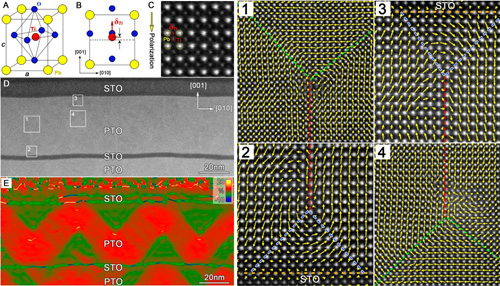Nanoscale ferroelectrics are expected to exhibit various exotic domain configurations, such as the full flux-closure pattern. These flux-closure domains should be switchable and may give rise to an unusually high density of bits as well as undergo vortex-polarization phase transformation. They are also predicted to be potentially useful as mechanical sensors and transducers. Similar domains are well known in ferromagnetic materials, and their topological properties and dynamics are under intense investigation. However, in ferroelectric materials, particularly in tetragonal ferroelectrics, the coupling of polarization to spontaneous strain would be so pronounced that formation of a closure-quadrant with its resultant severe disclination strains could be impossible.
The researchers at Institute of Metal Research, Chinese Academy of Sciences (IMR, CAS) recently discovered full flux-closures and their periodic array in ferroelectrics. On 16 April 2015, Science magazine published this discovery online in Science Express. This work was performed by a research team with leading scientists of Prof. MA Xiuliang, Prof. ZHU Yinlian and Dr. TANG Yunlong at the Solid Atomic Imaging Division, Shenyang National Laboratory for Materials Science (SYNL). Some of their domestic and international collaborators were also involved in this study.
The Solid Atomic Imaging Division at SYNL, IMR has a long-standing tradition with several decades of applying transmission electron microscopy to materials science. By engineering strain at the nanoscale, the microscopists have grown PbTiO3/SrTiO3 multi-layer films on a GdScO3 substrate. Using aberration-corrected scanning transmission electron microscopy, they observed not only the atomic morphology of the flux-closure quadrant but also a periodic array of flux-closures in ferroelectric PbTiO3 films, mediated by tensile strain on a GdScO3 substrate. They directly visualized an alternating array of clockwise and counter-clockwise flux-closures, whose periodicity depends on the PbTiO3 film thickness. In the vicinity of the core, the strain is sufficient to rupture the lattice, with strain gradient up to 109/m. Away from the vertex, the strain gradient estimated in the triangle domain is about 4×106/m. A flexoelectric coefficient as giant as 10-10C-1m3 is also derived.
The results provide a new similarity between ferroelectric and ferromagnet, and extend the potential of employing epitaxial strain for modulating ferroelectric domain patterns. Designs based on controllable ferroelectric closure-quadrants could be fabricated for investigating their dynamics and flexoelectric responses, and in turn assist future development of nanoscale ferroelectric devices such as high-density memories and high-performance energy-harvesting devices.

Figure. Long-range periodic disclination pairs in the ferroelectric PbTiO3 film. The superposition of HAADF-STEM images and Ti4+ displacement vector-maps shows the full closure-quadrants. (Image by IMR)
Key Words:Ferroelectric; Flux-closure domain; Atomic imaging
Contact:
Prof. MA Xiuliang
xlma@imr.ac.cn